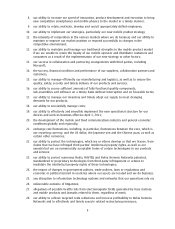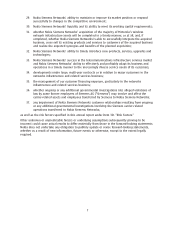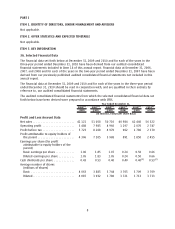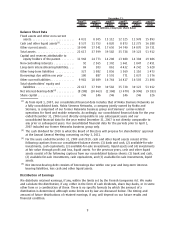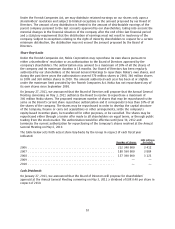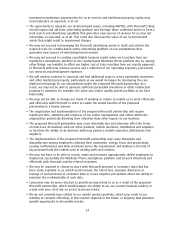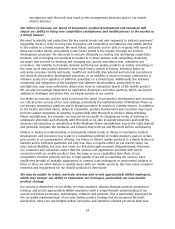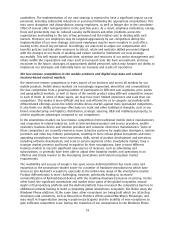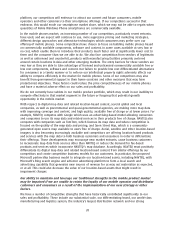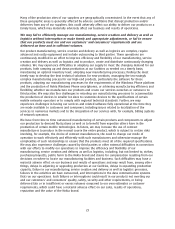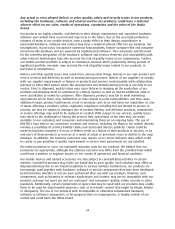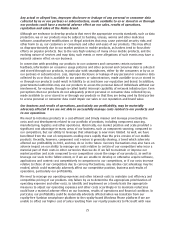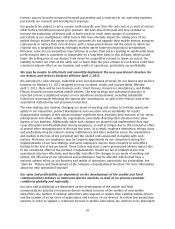Nokia 2010 Annual Report Download - page 17
Download and view the complete annual report
Please find page 17 of the 2010 Nokia annual report below. You can navigate through the pages in the report by either clicking on the pages listed below, or by using the keyword search tool below to find specific information within the annual report.Our ability to bring winning smartphones to the market in a timely manner will be
significantly impaired if we are unable to build a competitive and profitable global ecosystem
of sufficient scale, attractiveness and value to all participants.
The emergence of ecosystems in and around the mobile device market for smartphones represents the
broad convergence of the mobility, computing, consumer electronics and services industries. Different
industry participants—such as hardware manufacturers, software providers, developers, publishers,
entertainment providers, advertisers and ecommerce specialists—are forming increasingly large
communities of mutually beneficial partnerships in order to bring their offerings to the market. The nexus
of the major smartphone ecosystems is the operating system and the development platform upon which
smartphones are based and services built. We work with developers and other partners and collaborators
to create applications and provide services and content for our Symbian smartphones and utilize the Qt
development framework. Until very recently, we believed our competitive position in smartphones could
be improved with Symbian, as well as MeeGo, and our strategy based on those platforms. We are now of
the view, however, that for the longer term our Symbian platform is not sufficiently competitive in
leading markets and our MeeGo project is focused on longerterm nextgeneration mobile products.
Additionally, Symbian is proving to be a challenging development environment in which to meet the
continuously expanding consumer requirements and around which to build a competitive global
ecosystem of sufficient scale and attractiveness that brings value to all participants. Accordingly, on
February 11, 2011, we announced our intention to enter into a broad strategic partnership with Microsoft
and adopt Windows Phone as our primary smartphone platform designed to build a competitive global
mobile ecosystem for our smartphones.
Our ability to build a competitive global ecosystem for our smartphones is subject to certain risks and
uncertainties, which could, either individually or together, significantly impair our ability to bring
winning smartphones to the market in a timely manner. If that were to occur, our business would
become more dependent on sales in the mobile phones market, which is an increasingly
commoditized and intensely competitive market, with substantially lower growth potential, prices
and profitability compared to the smartphone market. Those risks and uncertainties include the
following:
• If we fail to finalize a partnership with Microsoft or the benefits of that partnership do not
materialize as expected, we will have limited our options to build a competitive smartphone
ecosystem with another partner or join another competitive smartphone ecosystem in a timely
manner.
• The Windows Phone platform may not achieve or retain broad or timely market acceptance or
be preferred by ecosystem participants, mobile operators and consumers.
• We may not be able to develop and execute with speed sufficient quantities of highquality
differentiated Nokia Windows Phone smartphones in order to achieve the scale needed for a
competitive global ecosystem and the success of our own business and results of operations.
• We may not be able to provide sufficient opportunities to innovate and customize on the
Windows Phone platform in order to attract developers and other ecosystem participants
seeking to differentiate their offerings on our smartphones from those of our competitors.
• We may not succeed in rapidly expanding the Windows Phone platform and related ecosystem
beyond its current use in highend smartphones to more affordable smartphones.
• Other competitive major smartphone ecosystems have advantages which may be difficult for
us to overcome, such as firstmover advantage, momentum, engagement by developers,
mobile operators and consumers and brand preference, and their advantages may become
even greater during our transition to the Windows Phone platform.
• The global ecosystem may not be flexible enough to allow local ecosystems to develop around
and in connection with it.
• Applicable developer tools may not gain needed traction or acceptance in the market, may be
16


